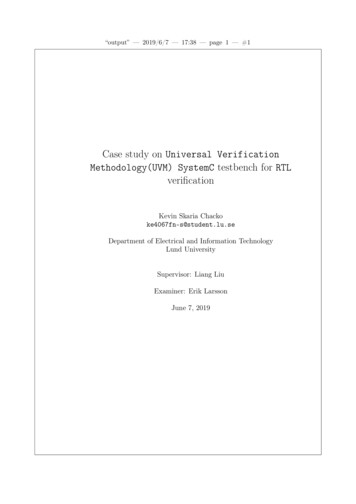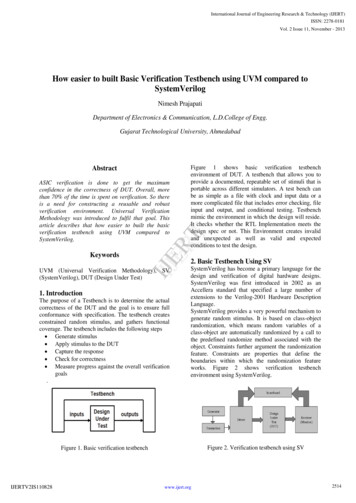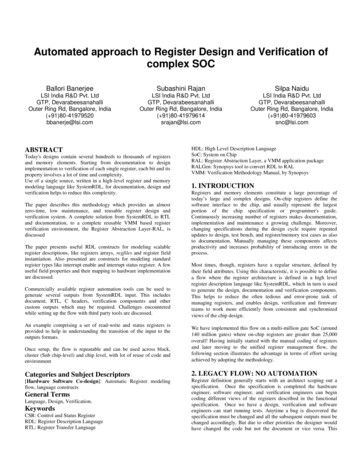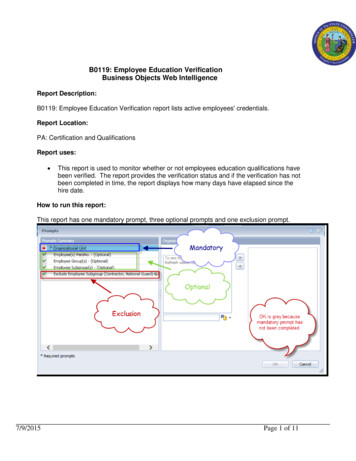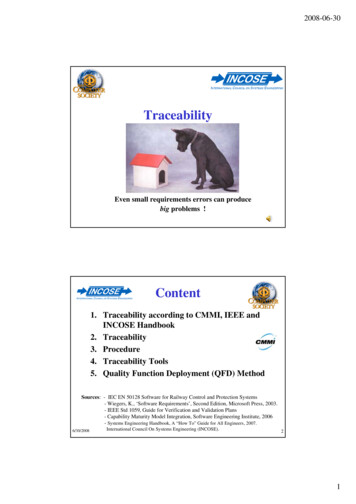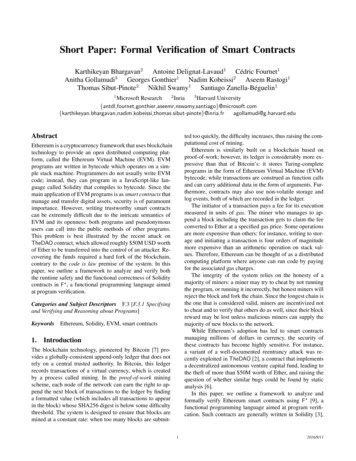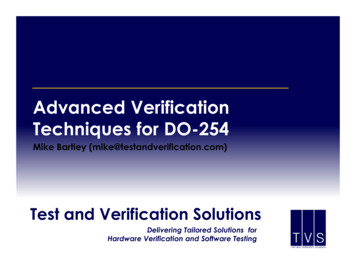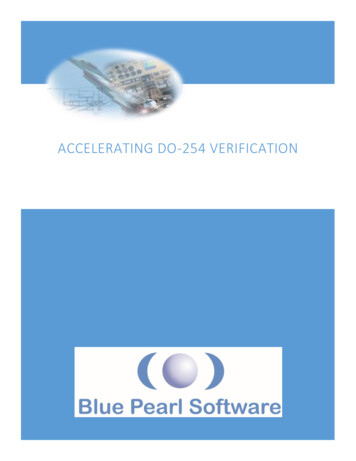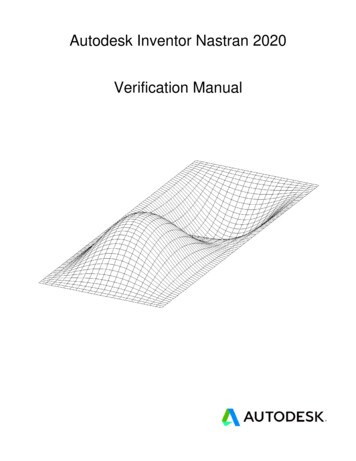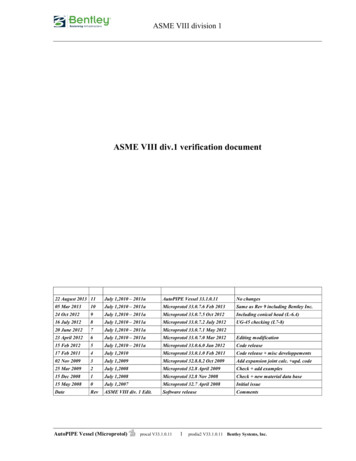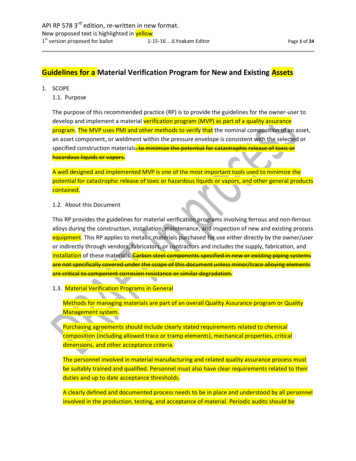
Transcription
API RP 578 3rd edition, re-written in new format.New proposed text is highlighted in yellow.st1 version proposed for ballot1-15-16 . JLYoakam EditorPage 1 of 24Guidelines for a Material Verification Program for New and Existing Assets1. SCOPE1.1. PurposeThe purpose of this recommended practice (RP) is to provide the guidelines for the owner-user todevelop and implement a material verification program (MVP) as part of a quality assuranceprogram. The MVP uses PMI and other methods to verify that the nominal composition of an asset,an asset component, or weldment within the pressure envelope is consistent with the selected orspecified construction materials. to minimize the potential for catastrophic release of toxic orhazardous liquids or vapors.A well designed and implemented MVP is one of the most important tools used to minimize thepotential for catastrophic release of toxic or hazardous liquids or vapors, and other general productscontained.1.2. About this DocumentThis RP provides the guidelines for material verification programs involving ferrous and non-ferrousalloys during the construction, installation, maintenance, and inspection of new and existing processequipment. This RP applies to metallic materials purchased for use either directly by the owner/useror indirectly through vendors, fabricators, or contractors and includes the supply, fabrication, andinstallation of these materials. Carbon steel components specified in new or existing piping systemsare not specifically covered under the scope of this document unless minor/trace alloying elementsare critical to component corrosion resistance or similar degradation.1.3. Material Verification Programs in GeneralMethods for managing materials are part of an overall Quality Assurance program or QualityManagement system.Purchasing agreements should include clearly stated requirements related to chemicalcomposition (including allowed trace or tramp elements), mechanical properties, criticaldimensions, and other acceptance criteria.The personnel involved in material manufacturing and related quality assurance process mustbe suitably trained and qualified. Personnel must also have clear requirements related to theirduties and up to date acceptance thresholds.A clearly defined and documented process needs to be in place and understood by all personnelinvolved in the production, testing, and acceptance of material. Periodic audits should be
API RP 578 3rd edition, re-written in new format.New proposed text is highlighted in yellow.st1 version proposed for ballot1-15-16 . JLYoakam EditorPage 2 of 24conducted at all stages to ensure that processes are being followed: that the techniques used tovalidate the materials meet requirements, and that processes are delivering consistent results.When MVP techniques identify materials that do not meet requirements, it is imperative tofollow existing quality processes, and correct root causes identified processes that led to thenonconforming product.Using the above with a well thought out and documented MVP process, PMI is invaluable in theoverall achievement of 100% material assurance.2. REFERENCES2.1. NormativeThe following referenced documents are indispensable for the application of this document. Fordated references, only the edition cited applies. For undated references, the latest edition of thereferenced document (including any amendments) applies. API 510, Pressure Vessel Inspection Code: In-service Inspection, Rating, Repair, andAlterationAPI 570, Piping Inspection Code: Inspection, Repair, and Rerating of In-service PipingSystemsAPI Recommended Practice 574, Inspection Practices for Piping System ComponentsAPI Recommended Practice 575, Guidelines and Methods for Inspection of ExistingAtmospheric and Low-pressure Storage TanksAPI Recommended Practice 576, Inspection of Pressure-Relieving DevicesAPI Recommended Practice 577, Welding Inspection and MetallurgyAPI Recommended Practice 751, Safe Operation of Hydrofluoric Acid Alkylation UnitsAPI RP 939-C, Guidelines for Avoiding Sulfidation Corrosion Failures in Oil Refineries2.2. InformativeThe following referenced documents are informative in the application of this document. Fordated references, only the edition cited applies. For undated references, the latest edition of thereferenced document (including any amendments) applies. API RP 571, Damage Mechanisms Affecting Fixed Equipment In the Refining IndustryAPI Recommended Practice 580, Risk-Based InspectionAPI 579-1/ASME FFS-1 Fitness-For-Service
API RP 578 3rd edition, re-written in new format.New proposed text is highlighted in yellow.st1 version proposed for ballot 1-15-16 . JLYoakam EditorPage 3 of 24ASME1 Boiler and Pressure Vessel Code: Section IIPart A: Material SpecificationsPart B: Ferrous MaterialsPart C: Nonferrous MaterialsPart D: Welding Rods, Electrodes, and Filler Metals ASME PCC-2, Repair of Pressure Equipment and PipingASME B31.3, Process PipingCSB2 Chemical Safety Board Bulletin 2005-04-B, “Positive Material Verification: Prevent ErrorsDuring Alloy Steel Systems Maintenance”NACE3 Paper No 03651, “Specification for Carbon Steel Materials for Hydrofluoric AcidAlkylation Units”PFI4 ES22, Recommended Practice for Color Coding of Piping -----------1ASME International, 3 Park Avenue, New York, New York 10016-5990, www.asme.org.2U.S. Chemical Safety and Hazard Investigation Board, Office of Prevention, Outreach, and Policy, 2175 K StreetNW, Suite 400, Washington, D.C. 20037-1848, 202-261-7600, www.csb.gov. Most CSB publications are posted on,and can be downloaded from the CSB web site, http://www.csb.gov/safety publications/docs/SB-Nitrogen-6-1103.pdf.3NACE International , 1440 South Creek Drive, Houston, Texas 77218-8340, www.nace.org.4Pipe Fabrication Institute, 511 Avenue of the Americas, #601, New York, New York 10011. www.pfi-institute.org.3.0 DEFINITIONS AND ACRONYMS3.1 Definitions3.1.1 Alloy Material - Any metallic material (including welding filler materials) thatcontains alloying elements, such as chromium, nickel, or molybdenum, whichare intentionally added to enhance mechanical or physical properties and/orcorrosion resistance. Alloys may be ferrous or non-ferrous based.3.1.2 Distributor - A warehousing supplier for manufacturers or suppliers of materialsor components.3.1.3 Fabricator - One who fabricates piping systems, or portions of a piping system,as defined by ASME B31.33.1.4 Heat - A batch of metal made at the same time, able to be traced from itsoriginal constituents and manufacturing process
API RP 578 3rd edition, re-written in new format.New proposed text is highlighted in yellow.st1 version proposed for .1.133.1.143.1.153.1.163.1.171-15-16 . JLYoakam EditorPage 4 of 24Inspection Lot - A group of items or materials of the same type from a commonsource from which a sample is to be drawn for examination. NOTE: Aninspection lot shall not include items from more than one heat.Level of examination - The specified percentage of the number of items to beexamined in an inspection lot.Lot size - The number of items available in the inspection lot at the time arepresentative sample is selected.Material manufacturer - An organization that performs or supervises anddirectly controls one or more of the operations that affect the chemicalcomposition or mechanical properties of a metallic material.Material nonconformance - A positive material identification (PMI) test resultthat is not consistent with the specified material.Material supplier - An organization that supplies material furnished and certifiedby a material manufacturer, but does not perform any operation intended toalter the material properties required by the applicable material specification.Material verification program - A documented quality assurance procedure usedto assess materials (which can include weldments and attachments whenspecified) in order to verify conformance to a specification as designated by theowner/user. The program should include a description of methods for materialtesting, component marking, and record-keeping.Mill Test Report (MTR) - A document issued and certified by the materialmanufacturer identifying an item according to its heat and confirmingconformance to specification. Mill test reports include the results ofspecification-required testing including the original chemical analysis.Owner-user - The organization that exercises control over the operation,engineering, inspection, repair, alteration, pressure testing, and rating of thepiping systems.Pressure-containing components - Items that form the pressure-containingenvelope of the piping system.Positive Material Identification (PMI) - A physical evaluation or test of a materialperformed to confirm that the material which has been or will be placed intoservice is consistent with what is specified by the owner/user. These evaluationsor tests may provide either qualitative or quantitative information that issufficient to verify the composition.Random - Selection process by which choices are made in an arbitrary andunbiased manner.Representative sample - One or more items selected at random from theinspection lot that are to be examined to determine acceptability of theinspection lot.
API RP 578 3rd edition, re-written in new format.New proposed text is highlighted in yellow.st1 version proposed for ballot1-15-16 . JLYoakam EditorPage 5 of 243.1.18 Standard reference materials - Sample materials for which laboratory chemicalanalysis data are available and are used in demonstrating the accuracy andreliability of a test instrument.3.2 AcronymsAPI American Petroleum InstituteASMEAmerican Society of Mechanical EngineersIDL Instrument Detection LimitLODLimit of DetectionLOQLimit of QuantizationMDLMethod Detection LimitMTRMill Test ReportMVPMaterial Verification ProgramNACENational Association of Corrosion EngineersPFIPipe Fabrication InstitutePMIPositive Material IdentificationRSDRelative Standard DeviationSDStandard Deviation
API RP 578 3rd edition, re-written in new format.New proposed text is highlighted in yellow.st1 version proposed for ballot1-15-16 . JLYoakam EditorPage 6 of 244.0 APPLICABILITY CONSIDERATIONS AND GENERAL CONCERNS4.1 Applicability A paragraph suggesting applicability key points in upstream, midstream and downstreamsectors is required 4.2 Carbon Steel Substitutions in Low Alloy Steel SystemsWhen considering the likelihood of material non-conformances, it is worth noting thathistorically the greatest number of material non-conformances with serious consequenceshave involved carbon steel components inadvertently placed into low alloy steel (e.g. 1¼Cr½Mo, 2¼Cr-1Mo, 5Cr-½Mo, 9Cr-1Mo) piping systems. There have been fewer nonconformances in stainless steel and nonferrous systems because of appearance andweldability issues.4.3 Alloy Substitutions for Carbon SteelWhen determining the need to perform material verification on carbon steel, theowner/user should evaluate the effect that the process stream could have on substitutedmaterials. In some cases, the substitution of hardenable alloy materials for carbon steel hasresulted in failure and loss of containment. Examples of such systems include those handlingwet hydrogen sulfide (H2S), hydrofluoric acid (HF), or sulfuric acid (H2SO4). Where materialsubstitution could lead to failure and/or loss of containment, the extent of verificationshould be planned and/or increased in effectiveness to validate the materials specified foruse4.4 Residual Elements In Carbon Steels In Hydrofluoric Acid Alkylation UnitsCarbon steels in some specific locations in HF acid service have been reported to sufferincreased corrosion rates based on the residual element (RE) content in the steels (refer toAPI RP 751.) PMI methods can be used to assess the suitability of materials for HF service incarbon steels according to RE content and the discussion within the context of thisdocument. Consideration should be given to the ability of the PMI method to detect thevarious elemental concentrations, which are miniscule in comparison to the bulk analysis.4.5 Process Units Susceptible To SulfidationCarbon steels with low silicon ( 0.10%) content can corrode at an accelerated rate whenexposed to hydrogen-free sulfidation conditions. These phenomena are discussed moreextensively in API RP 571 and API RP 939-C. Owner/users with assets at risk from this type of
API RP 578 3rd edition, re-written in new format.New proposed text is highlighted in yellow.st1 version proposed for ballot1-15-16 . JLYoakam EditorPage 7 of 24degradation should consider the risks and the requirements to apply PMI control in order todetermine silicon levels and the effect on predicted corrosion rate.4.6 Gasket MaterialsGaskets in incompatible service may cause premature failings. The principles outlined in thisdocument can also be applied to gasket materials. The owner/user is required to ascertainthe potential material variations and select analytical methods capable of providing therequired data. The actual test procedures can be more detailed due to the geometricstructure of the gasket materials.4.7 Refractory (anchors)Selection of refractory anchor metals shall be suitable for the anticipated operating conditions.PMI testing to verify the refractory anchors match specifications should be considered by theowner/operator. Material specifications and maximum design temperatures for selectedmaterials are discussed API Standard 560.5.0 MATERIAL VERIFICATION PROGRAMS5.1 GeneralThe owner/user shall establish a written material verification program indicating the extentand type of PMI testing to be conducted during the construction of new assets, retroactivelyon existing assets, and during the maintenance, repair, or alteration of existing assets.For higher-risk systems, the owner/user should consider the need for employing a higherlevel of
API RP 578 3rd edition, re-written in new format. New proposed text is highlighted in yellow. 1st Page version proposed for ballot 1-15-16 . JLYoakam Editor 1 of 24 Guidelines for a Material Verification Program for New and Existing Assets 1. SCOPE 1.1. Purpose The purpose of this recommended practice (RP) is to provide the guidelines for the owner-user to develop and implement a material .File Size: 834KBPage Count: 24


